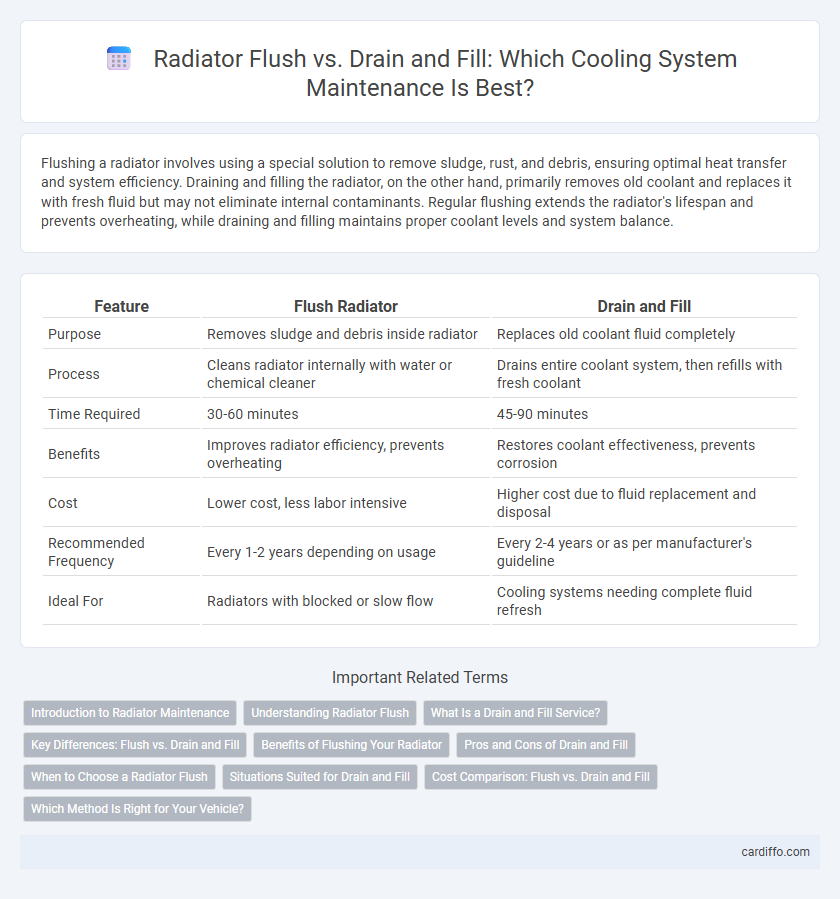Flushing a radiator involves using a special solution to remove sludge, rust, and debris, ensuring optimal heat transfer and system efficiency. Draining and filling the radiator, on the other hand, primarily removes old coolant and replaces it with fresh fluid but may not eliminate internal contaminants. Regular flushing extends the radiator's lifespan and prevents overheating, while draining and filling maintains proper coolant levels and system balance.
Table of Comparison
| Feature | Flush Radiator | Drain and Fill |
|---|---|---|
| Purpose | Removes sludge and debris inside radiator | Replaces old coolant fluid completely |
| Process | Cleans radiator internally with water or chemical cleaner | Drains entire coolant system, then refills with fresh coolant |
| Time Required | 30-60 minutes | 45-90 minutes |
| Benefits | Improves radiator efficiency, prevents overheating | Restores coolant effectiveness, prevents corrosion |
| Cost | Lower cost, less labor intensive | Higher cost due to fluid replacement and disposal |
| Recommended Frequency | Every 1-2 years depending on usage | Every 2-4 years or as per manufacturer's guideline |
| Ideal For | Radiators with blocked or slow flow | Cooling systems needing complete fluid refresh |
Introduction to Radiator Maintenance
Regular radiator maintenance is crucial for efficient engine cooling and preventing overheating. Flush radiator service involves removing old coolant and contaminants by circulating a cleaning solution, which improves heat transfer and prolongs radiator life. Drain and fill is a simpler process that replaces old coolant with fresh fluid, but does not eliminate rust, scale, or debris buildup inside the system.
Understanding Radiator Flush
Radiator flush is a vital maintenance procedure that removes accumulated rust, debris, and old coolant from the cooling system, improving engine performance and preventing overheating. Unlike drain and fill, which only replaces the coolant, a flush cleans internal components, ensuring better heat transfer and prolonging radiator life. Regular radiator flushes help maintain optimal coolant efficiency, reduce corrosion, and prevent blockages that can lead to costly repairs.
What Is a Drain and Fill Service?
A drain and fill service involves completely draining the radiator coolant and refilling it with fresh, manufacturer-recommended antifreeze to maintain optimal engine temperature and prevent corrosion. This process removes old, contaminated coolant that can reduce the efficiency of the cooling system, unlike a simple flush that only clears debris and sludge. Regular drain and fill services help ensure the radiator functions efficiently, extending engine life and preventing costly repairs.
Key Differences: Flush vs. Drain and Fill
Flush radiator involves using specialized cleaning agents and forced water flow to remove sludge, rust, and debris from the cooling system, enhancing heat transfer efficiency. Drain and fill simply replaces old coolant by draining the radiator and refilling it without addressing internal buildup or corrosion. Flush radiators provide a more thorough cleaning, improving long-term radiator performance, while drain and fill is a quicker, less intensive maintenance step.
Benefits of Flushing Your Radiator
Flushing your radiator removes accumulated dirt, rust, and debris that can hinder efficient heat transfer, improving the overall performance of your cooling system. It extends the lifespan of the radiator by preventing corrosion and blockages that cause overheating and costly repairs. Regular flushes enhance your vehicle's fuel efficiency and reduce the risk of engine damage compared to just draining and refilling the coolant.
Pros and Cons of Drain and Fill
Drain and fill is a cost-effective repair method that efficiently removes sludge and debris, improving radiator performance and preventing corrosion. However, it may not eliminate deep-seated blockages or fully restore severely damaged radiators, sometimes necessitating a flush or replacement. Regular drain and fill intervals can extend radiator lifespan but require careful handling to avoid introducing air pockets into the system.
When to Choose a Radiator Flush
A radiator flush is essential when your cooling system shows signs of sludge buildup, rust, or contaminated coolant that a simple drain and fill cannot remove effectively. Opt for a flush if the radiator coolant has not been changed for over two years or 30,000 miles, as accumulated debris can impair engine cooling and lead to overheating. Choose a flush over a drain and fill when your vehicle suffers from reduced heater performance, inconsistent engine temperature, or visible corrosion inside the radiator.
Situations Suited for Drain and Fill
Drain and fill is ideal for addressing extensive contamination or sediment buildup within a radiator system, ensuring thorough removal of old coolant and debris. This method suits situations where radiator performance suffers from corrosion or sludge accumulation that flushing alone cannot resolve. It effectively restores optimal heat transfer and system efficiency by completely replacing degraded fluid.
Cost Comparison: Flush vs. Drain and Fill
Flushing a radiator generally costs more than a simple drain and fill due to the additional labor and specialized equipment required to remove accumulated sludge and contaminants. Drain and fill services usually involve lower expenses, averaging between $100 and $150, while a full radiator flush can range from $150 to $250 depending on vehicle type and severity of build-up. Investing in a flush may prevent costly repairs over time by improving cooling system efficiency and prolonging radiator lifespan, potentially offsetting the initial higher cost.
Which Method Is Right for Your Vehicle?
Flush radiator involves using a cleaning solution to remove rust, sediment, and debris from the cooling system, improving radiator efficiency and preventing overheating. Drain and fill simply replaces old coolant with fresh fluid, maintaining optimal temperature regulation without addressing buildup. For vehicles with heavy corrosion or infrequent maintenance, a radiator flush is ideal, while regular maintenance often only requires a drain and fill.
Flush radiator vs drain and fill Infographic

 cardiffo.com
cardiffo.com